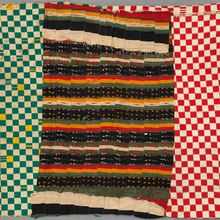Puppet Frame Cover
MOA: University of British Columbia
3420/80
Large textile that serves as a cover for the antelope puppet body frame (3420/99). Composed of three textiles, stitched together to create a large rectangluar textile, with another textile over the centre of the lower two. The top woven textile has horizontal bands of dark blue, dark green, and smaller bands of red, orange and green. There are small orange, red or white tassels in spaced in rows across the bands. The other two textiles form the bottom layer. One is red and white checkerboard, and the other is green and off-white checkerboard. There are roughly cut holes, three on one side, and two on the other, where puppets would be attached to the frame.
-
History Of Use
A mobile stage is covered with cloths, concealing the men inside, who move the stage across the dance area. Fitted in front with a wooden animal head (an antelope or buffalo mask), the stage itself is a large puppet. The performances are organized by the village youth organizations, kamalen ton. Sogo bò (“animals come out”) is a series of up to twenty discrete performative sequences, with short intervals of song and dance. Puppets are divided into merekun (large rod puppets) and maani (smaller figurative forms), joined together as ensembles. The puppet heads or figures poke out from the top of the cloth frame, and are made to twirl and dance. The puppets and masks depict animals, fantastic creatures, hunters and characters from village life. Short performances lasting between five to ten minutes focus on themes of family and village rivalry, jealously and unity, as well as masculine values and their identification with hunters. Bamana farmers and Bozo fishermen participate together in these performances now, but the oral tradition suggests puppet theater originated with the Bozo.
-
Narrative
Tchuemegne purchased these 20th century Sogobò puppets, textiles and frames (3420/79-100) from Mr. Amadou Fantasa, an elder from the village of Markala in central Mali, in 2019. Fantasa recalled that the puppets had been used in the biannual festivals marking the beginning of the rainy season (June), and related agricultural and fishing activities, and at the start of the dry season (Oct) to signal the coming of the grain harvest. He said the puppets had been in use from 2012-2016, but after that they were in storage. The "coming forth of the masks and puppets in Markala", frequently refered to as "Marakala Sogobò" or "Dobò", is now inscibed on UNESCO's List of Intangible Cultural Heritage.
- Type of Item cover
- Culture Bozo, Bamana
- Material fibre
- Measurements height 254.0 cm, width 236.5 cm (overall)
- Previous Owner Richard Tchuemegne
- Received from Richard Tchuemegne, Michael O'Brian Family Foundation, Museum of Anthropology Exhibitions Budget
- Made in Segou
- Creation Date between 1950 and 2000
- Ownership Date before February 5, 2020
- Acquisition Date on February 5, 2020
- Item Classes textiles
- Condition fair
- Accession Number 3420/0080
